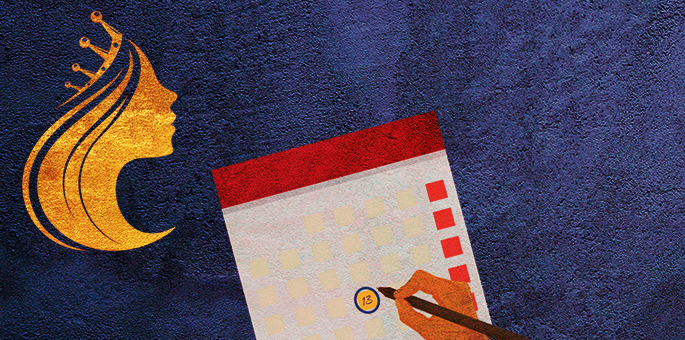The Fast of Esther (Taanit Esther) is a dawn-to-nightfall fast held on the day before the jolly holiday of Purim. It commemorates the fasting of our ancestors in response to the dramatic chain of events that occurred during their exile in the Persian empire. These events are recorded in the Book of Esther, and the salvation that came about at that time is celebrated on the holiday of Purim. (Click here to find out what times the Fast of Esther starts and ends in your location.)
This year the Fast of Esther is held on March 20, 2019, and Purim is celebrated that evening and the following day, March 21 (March 22 in Jerusalem). While the fast is generally celebrated on the day before Purim, when Purim is on Sunday, the fast is moved from Shabbat to the preceding Thursday.1
The Fast of Esther, or Ta’anit Esther, is not one of the four public fasts that was ordained by the prophets. Consequently, we are more lenient in its observance, particularly when it comes to pregnant women, nursing mothers and others who are weak.2
Click here for basic fast-day information.
What It Commemorates
Fasting is associated with some pivotal moments in the Purim narrative. One such moment is when Esther approached King Ahasuerus without permission in an effort to intercede on behalf of the Jewish people. Before she went to the king, she fasted for three days, and asked that all the Jews fast as well.
Another dramatic turnaround occurred on Adar 13 (the default date for the Fast of Esther), the date that Haman had set aside for killing the Jews. Instead the Jewish people soundly trounced their enemies. This triumph was accomplished while the Jews were fasting, as they prayed to G?d that they be successful.3
Click here for more on why this fast is named for Esther.
Extra Prayers
As on other fast days, we make the following changes to the daily prayer routine:
? During the morning prayers we recite selichot (penitential prayers), which are printed in the back of the prayerbook. The “long Avinu Malkeinu” is recited during the morning prayers (and the afternoon prayers, if the fast is not on the day before Purim) .
? The Torah is read during the morning and afternoon prayers. The reading—the same for both morning and afternoon—is Exodus 32:11–14 and 34:1–10, which discusses the aftermath of the Golden Calf incident, how Mosessuccessfully interceded on the Israelites’ behalf and obtained forgiveness for their sin. After the afternoon Torah reading, the special fast-day haftarah, Isaiah 55:6–56:8, is read.
? During the Amidah prayer of the afternoon service (Minchah), those who are fasting add the paragraph Aneinu in the Shema Koleinu blessing. (It is also added in the cantor’s repetition of the Amidah in both the morning and afternoon services as its own blessing between the blessings of Re’eh and Refa’einu.) Additionally, the priestly blessing is added in the repetition of the Amidah in the afternoon service.
? If the fast is on the day before Purim, we do not say Tachanun (prayers of supplication) or Avinu Malkeinu at Minchah, since the joy of the holiday is already upon us.
Machatzit Hashekel
In commemoration of the half-shekel contributed by each Jew to the Holy Temple—which the Talmud says counteracted the 10,000 silver talents Haman gave to King Ahasuerus to obtain the royal decree calling for the extermination of the Jewish people—it is customary to give three coins in “half” denominations (e.g., half-dollar coins) to charity on the afternoon of the Fast of Esther before Minchah. The three half-dollars given for every member of the family commemorate the three contributions the Jews gave for the building of the Tabernacle and for its sacrifices.
In many synagogues, plates are set out with silver half-dollars so that all can purchase them to use in observance of this custom.
Generally, we do not eat until after Megillah reading. If you find yourself in extenuating circumstances, consult with a rabbi to find out whether you can eat after nightfall but before the Megillah reading.3.
FOOTNOTES
- 1.Normally, when a fast falls on Shabbat, we delay the fast until Sunday, but because Purim is meant to be a festive day, we fast on the preceding Thursday. In honor of the Shabbat, we even refrain from fasting on Friday. (If, however, you forget to fast on Thursday, you should fast on Friday.)
- 2.Generally, we do not eat until after Megillah reading. If you find yourself in extenuating circumstances, consult with a rabbi to find out whether you can eat after nightfall but before the Megillah reading.
- 3.Presumably the Jews who were fighting did not fast, since they needed their strength to defend themselves. Since Esther, safe in the palace, was the only one not in danger, she was the only one to fast on this day. Based on the Rebbe’s talk on Purim 5730 (1970). See also Likkutei Sichot, vol. 6, pp. 371–372.
Source: Chabad.org
